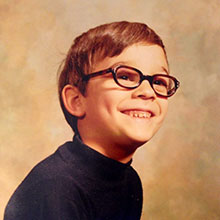
“Back to the Future: The Musical” redefines the concept of a star vehicle.
The production’s primary draw seems to be the DeLorean sports car-turned-time machine that’s featured in a couple of nifty special effects-filled scenes.
Prior to last Thursday’s opening night at the Orpheum Theatre, where the show’s national tour is parked through March 9, audience members jostled to take photos with a real vintage DeLorean stationed beneath the marquee. (Post-performance, I saw no one lingering by the stage door hoping to meet the production’s human cast members.)
Valuing movie nostalgia and theme park thrills more than thoughtful dramaturgy and thespian skills, the show frequently feels like it’s idling between its two big automated action scenes. Rather than fueling the plot, most of the musical numbers feel like detours, adding little but length to what ends up being a 2 ½ hour ride.
Given that there are perhaps 12 minutes of flying car hijinks, “Back to the Future” delivers shitty shitty bang for your entertainment buck.
Time keeps on slippin’
Much of the humor in the original “Back to the Future” film came from its clever contrasting of contemporary teenagers and the teens of the 1950s.
Plot refresher: Sixteen-year-old Marty McFly (Lucas Hallauer) accidentally crashes the DeLorean, souped up by his nutty professor pal Doc Brown (Don Stephenson), three decades in the past and becomes an inadvertent interloper in his own parents’ high school courtship.
But as any time travel afficionado will affirm, “contemporary” is only temporary.
Rather than genuinely rejuvenating their intellectual property by shifting their story’s time periods forward, Bob Gale (who hews close to his own screenplay in the musical’s book) and Alan Silvestri (composer of the film’s score and, in collaboration with Glen Ballard, the show’s original songs) opt for fossilization.
Which means “Back to the Future: The Musical” needs to back up further than the movie did. Instead of being about now and then, it’s about then and even thenner.
The ‘50s, perma-pressed into pop culture by “Happy Days” and “Grease,” fare better than the ‘80s, which are nebulously represented by lots of Lycra, big hair, and songs garnished with squiggly neon synth sounds that have since been effectively banned from pop music.
The ‘80s scenes are also so thinly written that audiences will have no sense of investment in Marty’s relationship with his girlfriend Jennifer (Kiara Lee) or his barely sketched dreams of becoming a rock star.
“Back to the Future,” the movie, was made for a target audience of 1980s teenagers, exalting in their culture while poking gentle fun at their parents’ era. But the musical makes the ‘80s look lame, appealing neither as a present-day past or a ‘50s future.
Mixed updates
The show does feature one undeniable comic gem: The ’50s scene in which Marty’s then-teenage mother-to-be, Lorraine Baines (Zan Berube, a perfectly calibrated comedian), tries to seduce her time-traveling son.
In the film, much of this scene’s punch hinged on Lorraine’s assuming, based on the waistband of his underpants, that her new crush’s name was Calvin Klein (Imagine an updated version, in which his briefs clued her into his being a Nasty Pig!).
That bit still works, but the musical amps up the yuk-yuk-ick factor of the ambient incest humor, with three pink-clad chorines appearing out of nowhere to sing back-up for Lorraine on a swoony “Pretty Baby.”
It’s delectably creepy, as if John Waters had donated an excised scene from “Hairspray.”
The Doc Brown character, played with antic battiness by Christopher Lloyd in the film, is here turned into a flimsy bridge between stage and screen. Don Stephenson plays the role with winking vaudevillian schtick that, in musical numbers, is accompanied by a phalanx of leggy dancers.
Stephenson/Brown regularly breaks the fourth wall to raise skeptical eyebrows, shrug, and shake his head in bewilderment at the silliness he finds himself in the midst of. It’s a skillful performance, but it’s hard not to think of him as an avatar for director John Rando, rolling his eyes at the audience and wondering how he got into this mess. Most of the jokes and lots of the dialogue are directly lifted from the screenplay, giving the whole show a bit of a slavish karaoke vibe.
Retro onerous
Amazingly, the most problematic, long-criticized scene from the film is left intact. The woozy music at a 1955 high school dance is provided by an all-Black combo specializing in slow doo-wop and Johnny Mathis style jams.
It’s jolted to life only when Marty, a classic California Caucasian, takes the stage and busts out a blues-rock rendition of Chuck Berry’s “Johnny B. Goode.”
Does the fact that Gale, Silvestri, and Ballard have shoehorned a barn-burning gospel tune into the show elsewhere (“Gotta Start Somewhere,” charismatically delivered by Catreze Tucker, playing minor Black character Goldie Wilson) somehow compensate for this? Not at all. It underlines it.
Overall, “Back to the Future” doesn’t look so bright.
